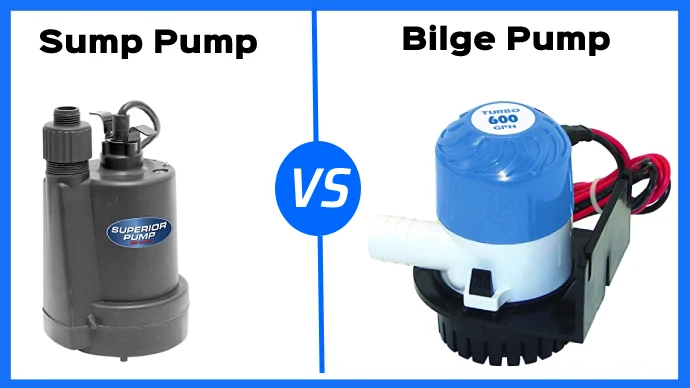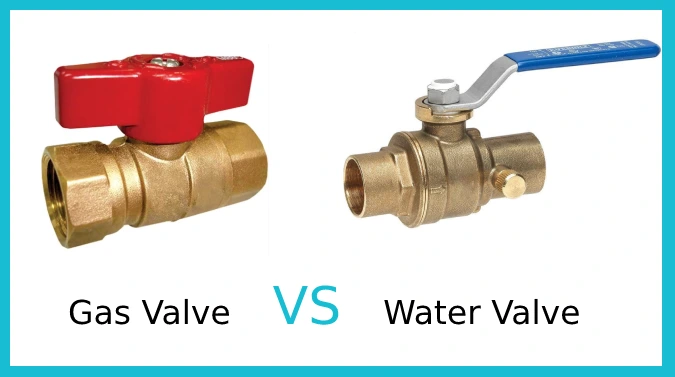Last Updated on May 18, 2023
With water constantly threatening to wreak havoc in flooded basements or boats, sump pumps and bilge pumps provide the perfect solution. While their purpose is similar, different pumping capacities mean each type has unique applications, making them powerful allies against unwanted standing water.
Larger sump pumps are ideal for those with a basement or crawl space to remove water during extreme weather conditions. Smaller bilge pumps may be an excellent investment for boat owners who need to remove small amounts of water from the bilge and quickly keep their boat water-free.
Today we will look closer at sump and bilge pumps, discussing their features and helping you choose which option best suits your needs. Keep reading to discover more about sump pumps and bilge pumps, and learn how to make an informed decision when selecting the right pump for your situation.
Sump Pump VS Bilge Pump: What are the Primary Differences?

Water in unwanted areas can cause significant damage and disturbance, whether in your basement or the boat’s bilge. This is where pumps come in handy. Pumps can effectively remove water from these areas and prevent further damage. However, not all pumps are created equal.
Here are some of the primary differences between these two pumps:
Pump Application
Bilge pumps and sump pumps differ in their respective applications. A bilge pump is specifically designed to remove water from the bilge, the lowest part of a boat. This pump is a critical piece of boat safety equipment that prevents water accumulation in this area, which can upset the boat’s balance.
In contrast, a sump pump typically draws water from a basement or crawl space, preventing water damage caused by flooding or high groundwater levels.
Size and Design
Another noticeable difference between bilge and sump pumps is size and design. Bilge pumps are typically smaller and less potent than sump pumps. The smaller bilge pumps allow easy installation in tight spaces, which is essential in the limited space of a boat’s bilge.
On the other hand, sump pumps are usually larger, and their design supports heavier usage since they are generally used to pump larger volumes of water from the basement or crawl space.
Activating Sensor
In terms of how they work, sump and bilge pumps differ significantly. Sump pumps typically have a float switch that activates the pump when the water level in the sump pit reaches a certain point. This means the pump only runs when needed, which can help conserve energy and prolong the pump’s life.
Bilge pumps may have a similar float switch, but they can also have a water sensor or manual bilge pump switch to activate the pump. This means that the automatic bilge pump may run more frequently than a sump pump, which can increase energy usage and wear and tear on the pump.
Pumping Capacity
Sump pumps are designed to handle larger volumes of water and are typically used to remove water from basements and other areas of a building below ground level. They are designed to handle relatively clean water and can quickly move large volumes of water.
Meanwhile, bilge pumps have a lower pumping capacity and are typically used to manage smaller amounts of water that accumulate in the hull of a boat or ship. They are designed to be compact and efficient and can handle saltier or more contaminated water than a sump pump.
Installation Place
Bilge pumps are commonly found at the bottom of boats, where they help pump out water that builds up in the bilge. Conversely, sump pumps are usually installed in a pit or sump basin in basements or crawl spaces of buildings.
This difference in installation location highlights the different uses of each pump, with bilge pumps being designed for maritime vessels while sump pumps are designed for residential or commercial structures.
Power Source
Bilge pumps are generally powered by boat batteries, which supply adequate power to pump water out of the bilge. In contrast, sump pumps are powered by electricity, meaning they draw power from the main electric supply of a building.
This means that sump pumps require a consistent power supply, while bilge pumps’ power source may depend on the state of the batteries or charging system.
Operation
Bilge pumps may be operated automatically or manually. The automatic function, the float switch, detects the water level, turns on the pump to pump out excess water in the bilge, and turns off when the water level goes below a certain threshold. Meanwhile, the manual operation requires someone to activate the pump.
In comparison, sump pumps are typically automatic, meaning they turn on automatically when water levels reach a certain point in the sump pit. This automatic operation ensures that sump pumps are always ready to pump out excess water without human intervention.
Does a boat have a sump pump and a bilge pump?

Boats have both sump pumps and bilge pumps. The bilge pump removes water that accumulates in the bilge, the lowest part of the boat where water tends to gather. The sump pump removes water from higher areas of the boat, such as the engine compartment, where water may collect due to rain or other sources.
Both pumps are critical for maintaining the safety and integrity of the boat, as they prevent water from building up and causing damage or even sinking the vessel.
Can you use a bilge pump and a sump pump in your house?
You can use both a bilge and a sump pump in your house. These pumps are commonly used in homes with basements or crawl spaces prone to flooding. A sump pump is typically installed in a small pit or basin, where it can collect water that enters the area and then pump it out to prevent flooding.
A bilge pump can also remove water that accumulates in low-lying areas of the home. Both pumps protect your home from water damage and maintain a safe and healthy living environment.
Are bilge pumps fully submersible?
Bilge pumps are fully submersible. This means they are designed to submerge in water without damage or malfunctioning completely. Bilge pumps are typically made from materials resistant to corrosion, such as stainless steel or marine-grade plastic, to ensure they can withstand the often harsh marine environment.
Also, many bilge pumps have automatic switches that turn them on and off as needed, further enhancing their reliability and performance.
Can I use a bilge pump instead of a sump pump in my basement?

It is important to note that bilge and sump pumps may seem interchangeable but differ. Bilge pumps are designed for boats and have a lower pumping capacity than sump pumps, specifically designed for basements and can handle larger volumes of water.
Using a bilge pump in your basement may not be appropriate, especially in the rainy season when there is a higher chance of flooding. The bilge pump may be unable to keep up with the volume of water in a basement, leading to further damage and potential safety hazards.
It is always best to use the appropriate tool for the job, and in this case, that would be a sump pump.
Where is the best location for a bilge pump on a boat?
The best place for a bilge pump on your boat is crucial for efficient functioning. Locate a spot on the hull far enough above the waterline that won’t submerge when the boat is fully loaded or heeling over. This ensures the bilge pump can effectively remove water from the bilge or engine compartment.
Also, it is essential to ensure that the bilge pump outlet is above the waterline, preventing water from coming back into the boat. Proper bilge pump installation and location are necessary to avoid flooding and to maintain the vessel’s and its occupants’ safety.
How long will a bilge pump run?

The length of time a bilge pump will run primarily depends on the amount of water in the bilge or engine compartment. Bilge pumps typically have a power draw of 5 to 15 amps at 12 VDC, and they can run for multiple 24-hour periods until the water is removed.
This pump will continue to run until the water level drops below the float switch or the manual switch are turned off. However, it is essential to regularly check the bilge pump to ensure it functions correctly and efficiently.
A malfunctioning bilge pump can lead to water damage, electrical hazards, and sinkage. Thus, bilge pump inspection and maintenance are recommended for regular boat upkeep.
From Sump to Bilge: Discover the Differences in Essential Water-Removing Pumps
Choosing the correct pump for your situation involves understanding the differences between sump and bilge pumps. While both sump and bilge pumps are used to remove unwanted water, they differ hugely in their application and pumping capacity.
Selecting the wrong pump according to your needs can have devastating effects, such as water damage, property loss, or even life loss. Therefore, assessing your needs and choosing the right pump is essential before purchasing.
Remember that choosing the proper pump for your needs requires carefully evaluating your situation, budget and water removal needs. Whatever your choice, a pump is an essential tool that every homeowner and boat owner should invest in to prevent property damage and ensure safety.



